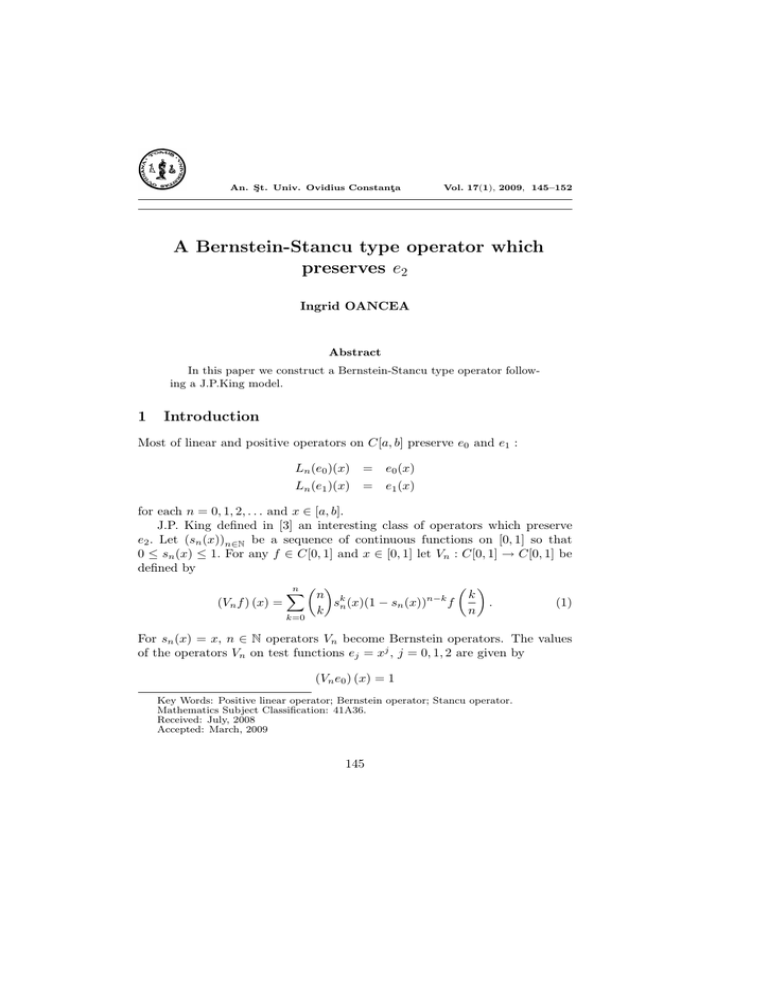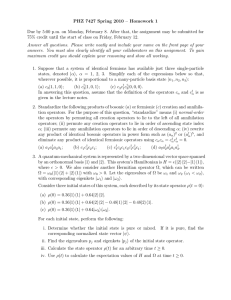A Bernstein-Stancu type operator which preserves e 1 Introduction
advertisement

An. Şt. Univ. Ovidius Constanţa Vol. 17(1), 2009, 145–152 A Bernstein-Stancu type operator which preserves e2 Ingrid OANCEA Abstract In this paper we construct a Bernstein-Stancu type operator following a J.P.King model. 1 Introduction Most of linear and positive operators on C[a, b] preserve e0 and e1 : Ln (e0 )(x) = e0 (x) Ln (e1 )(x) = e1 (x) for each n = 0, 1, 2, . . . and x ∈ [a, b]. J.P. King defined in [3] an interesting class of operators which preserve e2 . Let (sn (x))n∈N be a sequence of continuous functions on [0, 1] so that 0 ≤ sn (x) ≤ 1. For any f ∈ C[0, 1] and x ∈ [0, 1] let Vn : C[0, 1] → C[0, 1] be defined by (Vn f ) (x) = n X n k=0 k skn (x)(1 n−k − sn (x)) k f . n (1) For sn (x) = x, n ∈ N operators Vn become Bernstein operators. The values of the operators Vn on test functions ej = xj , j = 0, 1, 2 are given by (Vn e0 ) (x) = 1 Key Words: Positive linear operator; Bernstein operator; Stancu operator. Mathematics Subject Classification: 41A36. Received: July, 2008 Accepted: March, 2009 145 146 Ingrid OANCEA (Vn e1 ) (x) = sn (x) 1 n−1 2 sn (x) + s (x). n n n Using Bohman-Korovkin theorem ([1], [4]) it follows immediately that lim Vn f = (Vn e2 ) (x) = n→∞ f uniformly on [0, 1] if and only if lim sn (x) = x uniformly on [0, 1]. n→∞ In order to preserve e2 , the sn sequence has to be as it follows: ( s1 (x) = x2 q 1 + sn (x) = − 2(n−1) 2 n 2 n−1 x + 1 4(n−1)2 , n = 2, 3, . . . Main results D.D. Stancu (see [5], [6]) defined for two positive numbers 0 ≤ α ≤ β independent of n and for any function f ∈ C[0, 1] the operator, (Pn(α,β) f )(x) = n X pn,k (x)f k=0 k+α n+β (2) . α , a = The Bernstein Stancu operator uses the equidistant knots a0 = n+β 1 (α,β) 1 α x0 +h, . . . , an = x0 +nh where h = n+β and because Pn f (0) = f n+β (α,β) and Pn f (1) = f n+α n+β , interpolates function f in x = 0 if α = 0 and in x = 1 if α = β. Values on test function are given by: (3) Pn(α,β) e0 (x) = 1 α − βx Pn(α,β) e1 (x) = x + n+β (4) nx(1 − x) + (α − βx)(2nx + βx + α) (5) Pn(α,β) e2 (x) = x2 + (n + β)2 (α,β) so we can state that for any f ∈ C[0, 1] the sequence (Pn f )(x) n∈N converges uniformly to f (x) on [0, 1]. (α,β) We define now the operators Vn : C[0, 1] → C[0, 1] by Vn(α,β) f (x) = n X n k=0 k rnk (x)(1 n−k − rn (x)) f k+α n+β , (6) 147 A Bernstein-Stancu type operator for any function f ∈ C[0, 1] and x ∈ [0, 1]. It’s obvious that for rn (x) = x, n ∈ N the Bernstein-Stancu operators are obtained, and for a = β = 0 the Vn operators defined by (1) are obtained. (α,β) The Vn operators are linear and positive. Using the relations (3)-(5) the following theorem can be easily proved: (α,β) Theorem 2.1 The operators Vn have the following properties: 1. Vn(α,β) e0 (x) = 1 n α Vn(α,β) e1 (x) = rn (x) + n+β n+β 1 Vn(α,β) e2 (x) = n(n − 1)rn2 (x) + n(1 + 2α)rn (x) + α2 (n + β)2 2. For any function f ∈ C[0, 1] şi x ∈ [0, 1] we have lim Vn(α,β) f = f n→∞ uniformly on [0, 1] if and only if lim rn (x) = x n→∞ uniformly on [0, 1]. (α,β) Next we impose the condition Vn or e2 = e2 , that is 1 n(n − 1)rn2 (x) + n(1 + 2α)rn (x) + α2 = x2 2 (n + β) n(n − 1)rn2 (x) + n(1 + 2α)rn (x) + α2 − x2 (n + β)2 = 0. If we denote a = n(n − 1) b = n(1 + 2α) c = α2 − (n + β)2 x2 then the discriminant is given by ∆ = n2 (1 + 2α)2 − 4n(n − 1) α2 − (n + β)2 x2 = = n2 + 4nα(n + α) + 4n(n − 1)(n + β)2 x2 ≥ 0 (7) (8) (9) 148 Ingrid OANCEA for any x ∈ [0, 1]. For n 6= 1 the solutions of the equation are p −n(1 + 2α) ± n2 (1 + 2α)2 − 4n(n − 1) (α2 − (n + β)2 x2 ) (rn (x))1,2 = . 2n(n − 1) We choose rn∗ (x) = −n(1 + 2α) + p n2 (1 + 2α)2 − 4n(n − 1) (α2 − (n + β)2 x2 ) , 2n(n − 1) n>1 (10) and r1∗ (x) = x2 . (11) i h α the following inequality holds 0 ≤ , n+α Lemma 2.2 For any x ∈ n+β n+β ∗ rn (x) ≤ 1. Proof. Because rn∗ (x) = √ −b+ b2 −4ac 2a 0≤ −b + √ the inequality 0 ≤ rn∗ (x) ≤ 1 becomes b2 − 4ac ≤1 2a Since a > 0 we get which leads to p 0 ≤ −b + b2 − 4ac ≤ 2a p 0 ≤ b ≤ b2 − 4ac ≤ 2a + b b2 ≤ b2 − 4ac ≤ 4a2 + 4ab + b2 0 ≤ −ac ≤ a2 + ab. It results that we have to find x ∈ [0, 1] such that c≤0 . a+b+c≥0 Replacing a, b, c we obtain c ≤ 0 if α2 − (n + β)2 x2 ≤ 0, that is x ∈ and a + b + c ≥ 0 becomes h n(n − 1) + n(1 + 2α) + α2 − (n + β)2 x2 ≥ 0 x2 ≤ n+α n+β 2 i α n+β , 1 , i h i h n+α α therefore x ∈ 0, n+α n+β which eventually gives us that x ∈ n+β , n+β . , 149 A Bernstein-Stancu type operator If we denote In = h α n+α n+β , n+β i from the inequalities α n+α n+α+1 α ≤ ≤ ≤ n+β+1 n+β n+β n+β+1 it follows that In ⊂ In+1 , n ∈ N; moreover for n → ∞ the interval In becomes [0, 1]. One can notice that lim rn∗ (x) = x, so we have the following n→∞ (α,β) Theorem 2.3 The operators Vn given by 6 with the sequence (rn∗ (x))n∈N defined by 10, 11 have the following properties: 1. they are linear and positive on C[0, 1] h i (α,β) α 2. Vn e2 (x) = e2 (x), n ∈ N∗ for any x ∈ n+β , n+α n+β i h (α,β) α , n+α 3. lim Vn f = f for any f ∈ C[0, 1], x ∈ n+β n+β . n→∞ If L is a linear and positive operator on C[a, b], then for any continuous function f ∈ C[a, b] and x ∈ [a, b] we have the evaluation (see [2], pg. 30) (Lϕx )(x) |(Lf )(x) − f (x)| ≤ |f (x)| |(Le0 )(x) − 1| + (Le0 )(x) + ω(f, δ) ≤ δ ! p (Le0 )(x)(Lϕ2x )(x) ≤ |f (x)| |(Le0 )(x) − 1| + (Le0 )(x) + ω(f, δ) (12) δ (∀) x ∈ I, (∀) δ > 0, where ϕx = e1 − xe0 If the operator L satisfies the conditions Le0 = e0 şi Le2 = e2 then the evaluation (12) can be written as: ! p (Lϕ2x )(x) ω(f, δ) |(Lf )(x) − f (x)| ≤ 1 + δ and since (Lϕ2x )(x) = L (e1 − xe0 )2 , x = (Le2 ) (x) − 2x (Le1 ) (x) + x2 (Le0 ) (x) = = 2x2 − 2x (Le1 ) (x) = 2x (x − (Le1 ) (x)) , we can also write that |(Lf )(x) − f (x)| ≤ 1+ p 2x (x − (Le1 ) (x)) δ ! ω(f, δ) (13) 150 Ingrid OANCEA for any f ∈ C[a, b] and x ∈ [a, b]. Since the operator L is positive and ϕ2x ≥ 0 we get that Lϕ2x ≥ 0 which is equivalent with 2x (x − (Le1 ) (x)). It follows that for any x ∈ [a, b], a ≥ 0 the inequality (Le1 ) (x) ≤ x. holds true. (α,β) Taking [a, b] = In and L = Vn as a particular case we obtain: Lemma 2.4 For any x ∈ In if rn (x) = rn∗ (x) we have Vn(α,β) e1 (x) ≤ x. (α,β) (α,β) e2 (x) = We got that for any x ∈ In we have Vn e0 (x) = e0 (x), Vn (α,β) e2 (x) şi Vn e1 (x) ≤ x; therefore the following evaluation stands: r (α,β) (x) 2x x − V e n 1 (α,β) ω(f, δ). 1 + f )(x) − f (x) ≤ (Vn δ The order of approximation is at least as good as in case of approximation by Bernstein-Stancu polynomials for those x ∈ In for which the following inequality is true (Vn(α,β) ϕ2x )(x) ≤ (Pn(α,β) ϕ2x )(x). (14) For n > β 2 the second order moment of Stancu operator is given by (Pn(α,β) ϕ2x )(x) = (Pn(α,β) (e1 − xe0 )2 )(x) = nx(1 − x) + (βx − α)2 . (n + β)2 (15) Taking into account the expressions of the moments for the two operators from relations (13) and (15), we can rewrite the inequality (14) as: nx(1 − x) + (βx − α)2 n α ∗ ≤ 2x x − rn (x) + . (16) n+β n+β (n + β)2 We present the graphics of the two members of inequality for some particular cases: 151 A Bernstein-Stancu type operator −7 x 10 3 Pn Vn 2.5 2 1.5 1 0.5 0 −0.5 0 0.2 0.4 0.6 0.8 1 n = 1.000.000; α = 10; β = 100 −7 14 x 10 Pn Vn 12 10 8 6 4 2 0 −2 0 0.2 0.4 0.6 n = 1.000.000; α = 100; β = 1.000 0.8 1 152 Ingrid OANCEA −6 4 x 10 Pn Vn 3.5 3 2.5 2 1.5 1 0.5 0 −0.5 0 0.2 0.4 0.6 0.8 1 n = 1.000.000; α = 900; β = 1.000 References [1] H. Bohmann, On approximation of continous and analytic functions, Ark. Mat. 2 (1952), 43-56. [2] R.A. DeVore, The approximation of continuous functions by positive linear operators, Lecture Notes in Mathematics 293, Springer-Verlag, New York, 1972. [3] J.P. King, Positive linear operators which preserve x2 , Acta Math. Hungar. 99(3)(2003), 203-208. [4] P.P. Korovkin, On convergence of linear positive operators in the space of continuous functions, Dokl. Akad. Nauk. SSSR (NS), 90 (1953), 961-964. [5] D.D. Stancu, Folosirea interpolării liniare pentru construirea unei clase de polinoame Bernstein, Studii şi Cercetări Matematice, 3 (28), (1976), 369-379. [6] D.D. Stancu, Asupra unei generalizări a polinoamelor lui Bernstein, Studia Universitatis Babeş-Bolyai, 14 (2) (1969), 31-45. Valahia University of Târgovişte, Department of Mathematics, Bd. Unirii No 18, 130082, Târgovişte, Romania ingrid.oancea@gmail.com




